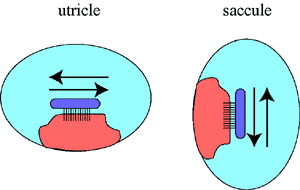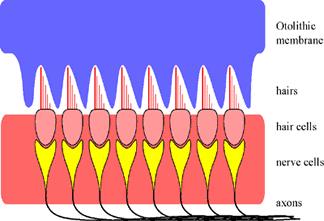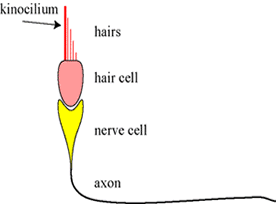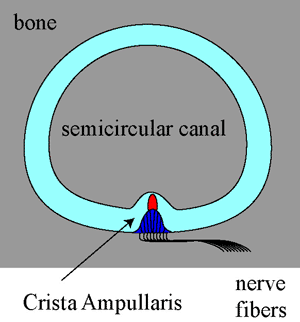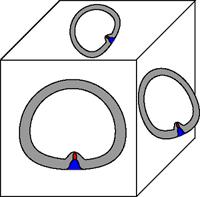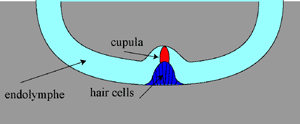Page Links:
A. Introduction:
The vestibular system can be divided into two parts:
a. the parts that detect linear acceleration (utricle and saccule); also called staticmovements
b. the parts that detect rotational acceleration (the three semi-circular canals); also called dynamic movements.
- The Utricle and the Saccule:
The utricle and the saccule are fluid-filled spaces. They contain a macula which is oriented in the horizontal direction (= utricle) or in the vertical direction (= saccule). These two organs therefore detect movements in the horizontal and in the vertical direction.
2. The Macula:
The macula is the sensor in these two organs. It essentially consists of a row of hair cells. The hairs are connected to a gelatinous mass called the otholithic membrane. The other side of the hair cell is connected to a nerve. This is the beginning of the vestibular nerve.
3. The Hair Cell:
In contrast to the hair cells in the cochlea, there is also an orientation in the configuration of the hairs in the macula. One of the hairs is longer and thicker than the others. This special hair is called a kinocilium (plural kinocilia) and is, as it were, a point of reference for these hairs.
4. How does it work?
When the head starts to move in one direction, the otolithic membrane will move in the opposite direction. This is due to the inertia of the otolith. Because the hair cells move in one direction and the otolithic membrane in the other, all the hairs will bend. As we have seen before in the organ of Corti, this will influence stretch channels in the neighbourhood to open, thereby depolarizing the membrane and generating action potentials.
5. Forward and backward or up-and-down?
But in the saccule and the utricle, there is an additional problem. These two organs must also detect whether the horizontal movement is forward or backward (or in the case of a saccule; vertical movement, up or down). As shown in the diagram, this is solved in the following manner. If the hairs bend towards the kinocilium, then there will be a depolarization in the hair cell. If the hairs bend the other way, away from the kinocilium, then the hair cell will hyperpolarize.
6. Frequency modulation:
The final step is to transduce (=translate) the depolarization into action potentials. As in the organ of Corti, depolarization causes more action potentials and the frequency becomes higher. This is because the polarity moves closer to the threshold. The opposite happens when the polarity moves away from the threshold. Then, during hyperpolarization, there will be less action potentials; the frequency is lower. This transduction from amplitude to frequency is (technically) called “frequency modulation” (like in the radio! FM vs. AM).
7. Acceleration versus velocity.
8. Frequency modulation.
Note that when the utricle or the saccule are in rest, that then the hair cells still generate action potentials. In other words, it is actually telling the brain that it is working and that there is at the moment no acceleration or deceleration. But if the frequency increases or decreases, then it can report how much (the change in frequency) and in which direction(accelerating or decelerating).
- The semi-circular canal:
2. The orientation of the three semi circular canals.
The three canals are oriented in three different directions and at right angles to each other. Like the three faces of a cube: one is at the front plane, one at the side plane and the third at the top plane. In this way, rotation at any angle can be picked up by one or two canals.
3. The Crista Ampullaris
As in the macula, there are hair cells in the bottom of the canal. The hairs are fixed to a “cupula” (= sort of a hat) which is a gelatinous mass. This cupula can turn left or right, depending on the flow of the endolymph.
4. How does it work?
When the head starts to rotate, the bone (=skull), and therefore the canal will also start rotating. But the endolymphe, due to its inertia, will not move immediately. So, if the head rotates in direction a, then the fluid, which lags behind, will flow in the opposite direction (b). This fluid flow will push the cupula to bend to the left (c). If the head rotates in the opposite direction, then of course, the fluid will also flow in the opposite direction and the cupula will bend to the right.
5. Frequency Modulation
As in the saccule and utricle, it is crucial to know whether the head its rotating to the right or to the left. Therefore, in a similar way, there is a system of modulating the intracellular potential to action potential frequency. Thus, rotation in one direction will increase the (resting) frequency whereas rotation in the opposite direction will cause a decrease in the resting frequency.
1.
Three systems are involved in our balance:
a. the vestibular system
b. the visual system
2. Proprioception:
This is the system that informs the brain of our “position” in space. Sensors are located in the joints (to measure the angle), in the skeletal muscles (to measure their length) and especially in the neck (to determine the relation of the head to the rest of the body).
3. Vestibular nuclei:
All this information is fed into the vestibular nuclei for processing. In addition, there is a close relation between these nuclei and the cerebellum (=auto pilot).
4. Effectors:
From the vestibular nuclei, commands are given to the eye muscles, the trunc, the limb and the neck muscles to either keep the shape of the body or to change it according to demand. The role of the neck is very visible in animals with long necks such as horses and camels. The animal can rotate its neck to look, for example, behind itself. When the animal then wants to move in that direction, then the body, as it where, “follows” the neck.
5. Vestibular nuclei:
All this information is fed into the vestibular nuclei for processing. In addition, there is a close relation between these nuclei and the cerebellum (=auto pilot).
6. Effectors:
From the vestibular nuclei, commands are given to the eye muscles, the trunc, the limb and the neck muscles to either keep the shape of the body or to change it according to demand. The role of the neck is very visible in animals with long necks such as horses and camels. The animal can rotate its neck to look, for example, behind itself. When the animal then wants to move in that direction, then the body, as it where, “follows” the neck.
7. When are we in balance?
We are in balance when the information from the three systems agree with each other. For example, suppose that you are in an elevator which looks outside (as in some expensive hotels) and you go up in that elevator. Then your eyes tell you that you are going up, your sacule feels that you are going up and the pressure sensors in your musculo-skeletal system informs the brain that the body is moving upwards.
8. Motion sickness
But if there is a conflict between the information received from one (or two) of the three systems, then we become violently sick: motion sickness. This is well known when one is on a boat in a choppy sea. Another current example is trying to read a book while riding in a car. Your eyes concentrate on the reading (stable) while your vestibular system and your proprioception inform you that you are constantly accelerating and decelerating. Good reason to become very very sick.
9. Symptoms:
The symptoms of motion sickness are quite severe:
- nausea
- vomiting
- pallor
- rapid breathing
- sweating
10. Why so severe?

